This page represents an initial effort at an on-line record of snowdrops (Galanthus species and hybrids) here at Gelli Uchaf. When we acquired the derelict property that is now our home, there was no garden, no flowers save a few old daffodils on our track banks, and certainly no obvious snowdrops for several miles around us. First created just after the first snowdrops emerged in October 2017, this page shadows a huge effort I made during the 2017 snowdrop season to photograph, label and record the majority of the different snowdrops which we then had growing here. It’s been updated a bit since.
We’re currently one of the few NGS gardens in Wales to open as part of their Snowdrop Festival: (Do watch any videos on the HD setting on the cog next to the YouTube logo):
For me, the delight from growing snowdrops comes mainly from having masses of flowers in the garden very early in the year. But knowing which ones are garden worthy and will thrive in our wet conditions has been an evolving challenge, which has gradually led to being able to create vistas like these taken in February 2022 on one of those fairly rare days when the sun shone, without a hard frost!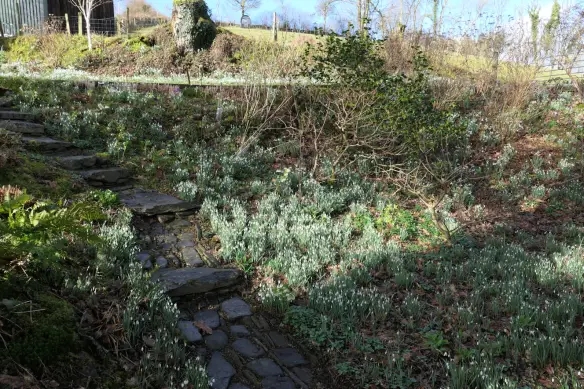



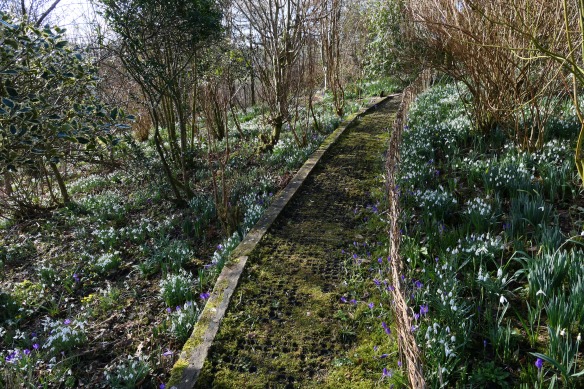

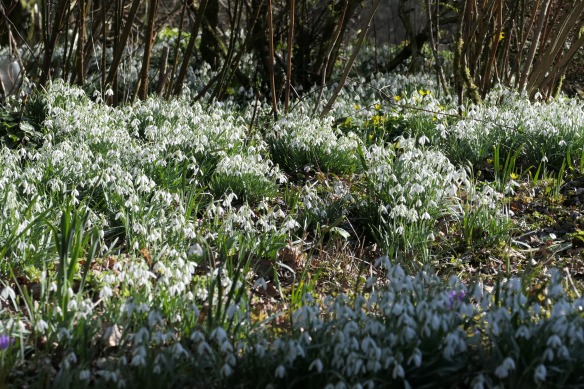

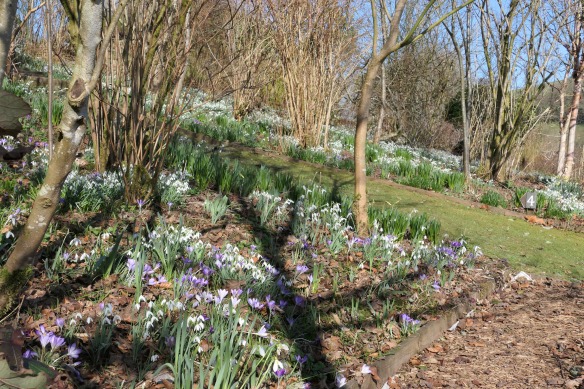

The main reason for this more detailed record of cultivars was that any other sort of simple physical record of these bulbs could easily be lost or damaged. And to be of value to any garden (or blog) visitors, some sort of order and accessible database of photographic images had to be created. Perhaps also for anyone thinking of trying to grow a few different snowdrops for the first time, a little of the reasons behind this simple record might be helpful.
Perhaps it might also help to hint at the appeal of galanthophilia (love or even obsession, with snowdrops) which seems to afflict a small, but growing number of gardeners. The fact that so many frankly only subtly different variants have names associated with the people who found them, or places of origin, links the real appeal of snowdrop sharing – human stories of loved places and the planting of these bulbs to illuminate the scene during the darkest months of the year, when much else outside is dormant or lifeless.
Candles of hope, hinting at the exuberance of spring, a few weeks ahead. And tough enough to cope with whatever winter chucks at them. Googling “thermogenesis in snowdrops” was indeed the cue for me deciding to start a blog of life here, back in early spring 2011, after finding the blog of Carolyn Walker – a confirmed fellow galanthophile and nursery owner in Pennsylvania.
Being quite a novice as far as snowdrops are concerned (say 20 years), I decided a few things were important for these records:
- Many available images of snowdrops show just single photos of the flowers fully open so that you can see the inner segment markings, but often not the rest of the plant. Very appealing to showcase a flower. BUT!!! In many years in our damp upland climate, the occasions when the flowers actually open perfectly like this can be extremely limited. Perhaps just a few hours in total during the season. This is also why getting decent photos of them in situ in the ground is tricky, in poor light. Or wind. Or rain. Or all 3. Last year a camera upgrade with a greater ISO range, helped this project progress.
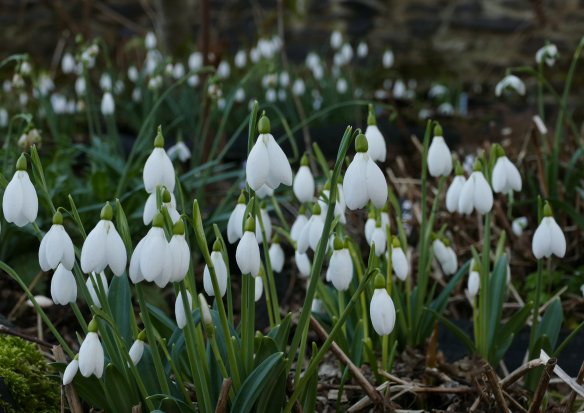 Also, the appeal of these earliest of flowers, for me, is much more tied up with the impact of the whole plant – foliage and flower – in persuading me outside, daily, whatever the weather, through the winter months to see the progress of their appearance. Even sun all day on December 18th 2017, couldn’t persuade many of the flowers of G. ‘Mrs. Macnamara’ to open, below.
Also, the appeal of these earliest of flowers, for me, is much more tied up with the impact of the whole plant – foliage and flower – in persuading me outside, daily, whatever the weather, through the winter months to see the progress of their appearance. Even sun all day on December 18th 2017, couldn’t persuade many of the flowers of G. ‘Mrs. Macnamara’ to open, below.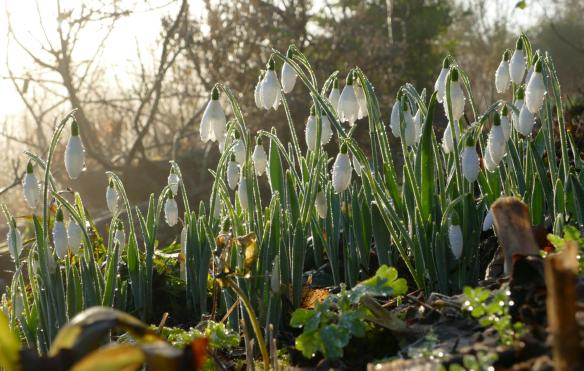 So I’ve tried to illustrate just how this visual impact of the plants changes from when the first flower stem, or “scape”, pushes up through the soil. Inevitably with taking so many photos, some aren’t as good as I’d like, and some varieties don’t yet have a good selection of images available for me to use, in spite of taking nearly 6,000 photos in the 2017 snowdrop season alone.
So I’ve tried to illustrate just how this visual impact of the plants changes from when the first flower stem, or “scape”, pushes up through the soil. Inevitably with taking so many photos, some aren’t as good as I’d like, and some varieties don’t yet have a good selection of images available for me to use, in spite of taking nearly 6,000 photos in the 2017 snowdrop season alone.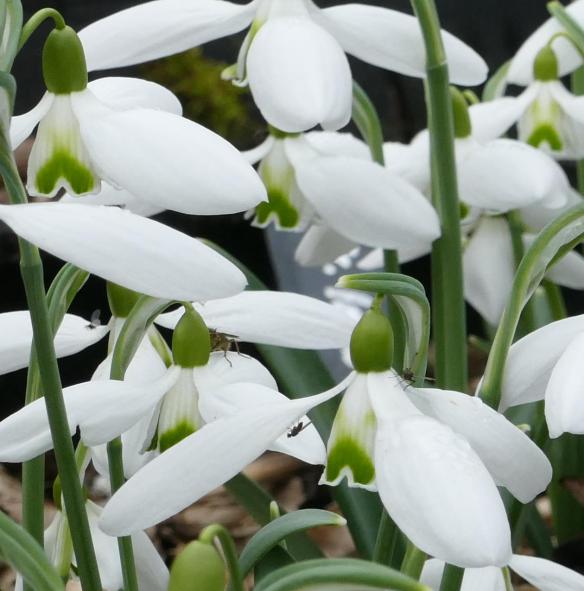
- For similar reasons, when the flowers first appear is very important to me. Which is why I’ve listed them not alphabetically, but in order of appearance (beginning in 2017). Having recorded opening sequences for a few years now, there seems to be a remarkably good correlation for most varieties, relative to other cultivars, from one year to the next, give or take a few days – even with weather differences. Also as of 2020, there’s clear evidence that left undisturbed, many forms’ flowering times creep a little earlier each year – possibly because replacement bulbs tend to end up nearer the soil surface. If you want to plan for a long season of snowdrops within a garden, having a good idea of relative flower opening times is very important.
 Though even within a single garden, considerable variation in flower opening times will be the result of subtle micro-climate differences, and other factors around the garden. If you want to search these records more quickly for a particular snowdrop, you can just type in the name in the search box at the top right of this page, above the header photo.
Though even within a single garden, considerable variation in flower opening times will be the result of subtle micro-climate differences, and other factors around the garden. If you want to search these records more quickly for a particular snowdrop, you can just type in the name in the search box at the top right of this page, above the header photo.
- My definition of first flower “opening” (shown in bold italics in the description) in these lists relates to the point at which the first flower bud of a variety emerges from the spathe (the spear like sheath which protects the flower as it is forced up through the earth), and begins to turn towards horizontal. This is really when the snowdrop flowers start to have an impact on the scene (from a human perspective). And this change from vertical to horizontal nearly always happens very quickly, in less than 24 hours, and often overnight provided ambient temperatures are high enough.
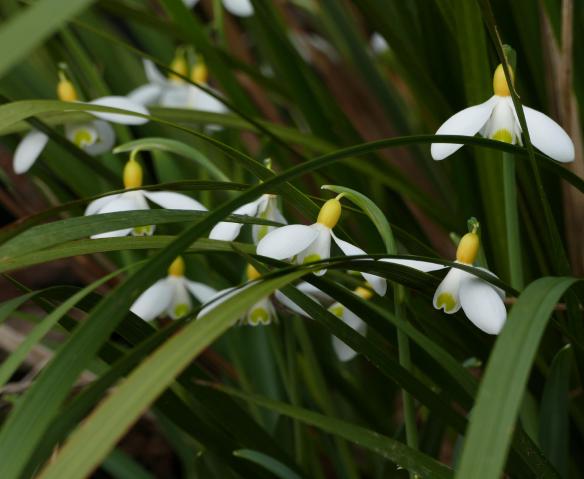
- I might add more detail on leaf and flower form with time, since such minutiae of detail do help with cultivar identification, but to people with no knowledge of this terminology, I think it would just make things more complicated for this sort of simple guide. (How often do the snowdrops look like those below, with outer segments spread wide? Not very often here in 2017, or 2018).

- Gradually, I shall highlight those varieties that seem particularly garden worthy, at least in our garden. As with all groups of plants, nurseries rarely record this very important detail, but how vigorous or floriferous a variety turns out to be in our conditions, is what I’m interested in. Not simply how unusual a flower is. Since it’s when snowdrops flower en-masse, that they really wow me.
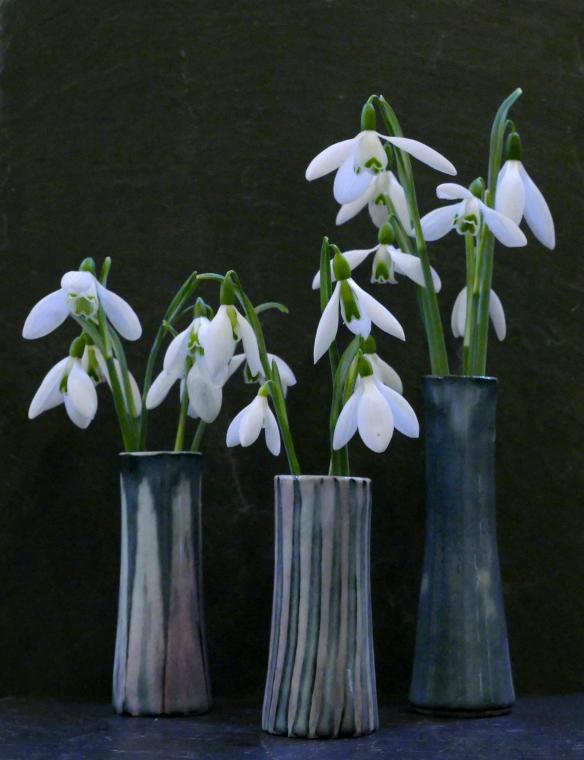 To be fair to the nurseries, although some older named cultivars may have good anecdotal information on vigour, the rush to get the latest new form onto the market for serious galanthophiles, (probably by very carefully slicing or “twin-scaling” the bulbs to bulk them up more quickly), means that this feedback from gardeners on how they perform in the ground may simply not be available. Perhaps another very good reason for any budding galanthophile to avoid the latest, most expensive offerings?
To be fair to the nurseries, although some older named cultivars may have good anecdotal information on vigour, the rush to get the latest new form onto the market for serious galanthophiles, (probably by very carefully slicing or “twin-scaling” the bulbs to bulk them up more quickly), means that this feedback from gardeners on how they perform in the ground may simply not be available. Perhaps another very good reason for any budding galanthophile to avoid the latest, most expensive offerings? 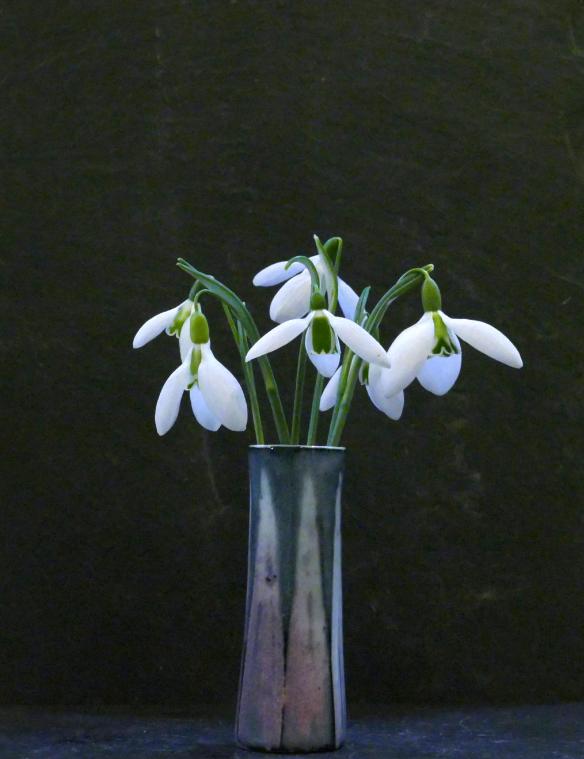 Sadly, a significant proportion of the named snowdrops which I’ve tried to grow, take so long to bulk up here that I don’t think they fall into this critical garden worthy category. Like G. elwesii ‘Peter Gatehouse’ below, at least in our garden:
Sadly, a significant proportion of the named snowdrops which I’ve tried to grow, take so long to bulk up here that I don’t think they fall into this critical garden worthy category. Like G. elwesii ‘Peter Gatehouse’ below, at least in our garden:

- Some snowdrops remain unnamed or unidentified in these lists and increasingly there will be several with the WHSH prefix, which indicates that they are part of my Welsh Historic Snowdrop Hunt project. For more information on the ideas behind my WHSH project, please click here. I’m extremely grateful to all the wonderful people who have allowed me to visit, photograph and collect sample bulbs, and also given me the fascinating human stories that usually accompany “old” snowdrop sites. Most of these varieties do indeed fall into the garden worthy category – at least for this wetter part of the world.

- Anyone looking for expensive rarities or the latest named cultivars in this list will be disappointed. I have a very modest upper maximum price for buying a snowdrop bulb – not much more than a nice bottle of wine (and I don’t drink anyway). It really is more important for me to have reliable good doers which create an extended season of interest, and anyway, if a new variety is expensive and a good doer, then quite quickly it will become more affordable. The wonders of time and biological multiplication, (generally following the Fibonacci sequence), working well without any recourse here to the artificial “twin-scaling” of bulbs for propagation, which I’ve never had the time or enthusiasm to carry out. Yet.
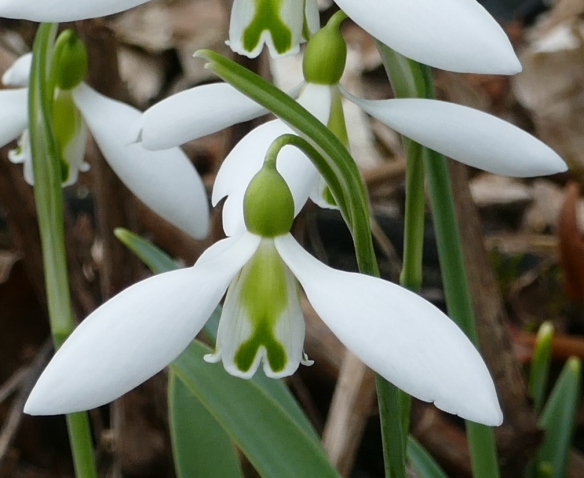
- To make these records more manageable, I’ve somewhat arbitrarily grouped the different cultivars, or forms, into 3 seasons, and this initial list runs from the very early flowering types, sometimes in October, to the middle of January based on when the first flowers appear. To illustrate the fact that snowdrops are really very variable in height, flowering time, markings and form, all the flowers below are different varieties which were in bloom here on New Year’s day 2018, when many would think the snowdrop season hadn’t even begun.

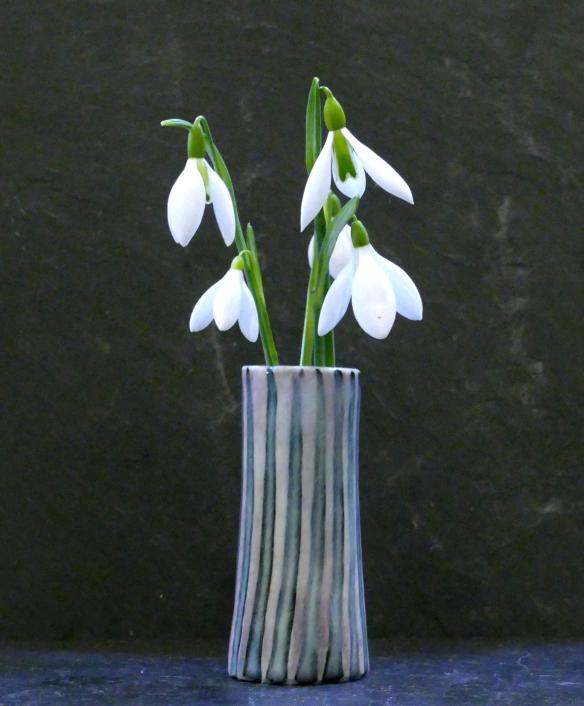
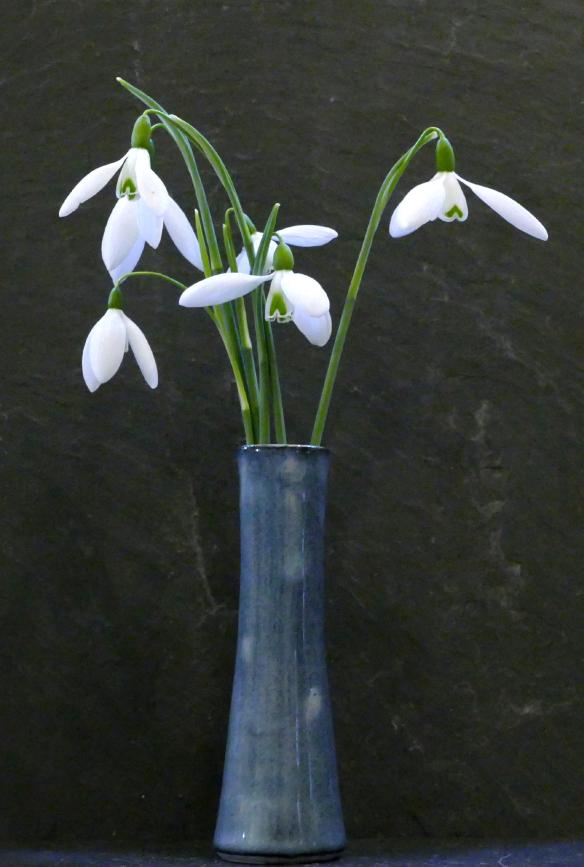 Typically an early season individual flower will last for up to 6 or 7 weeks, but as a clump becomes larger, the spread of flowering times means at least a good 2 or even 3 months of flower interest is possible from a single cultivar.
Typically an early season individual flower will last for up to 6 or 7 weeks, but as a clump becomes larger, the spread of flowering times means at least a good 2 or even 3 months of flower interest is possible from a single cultivar.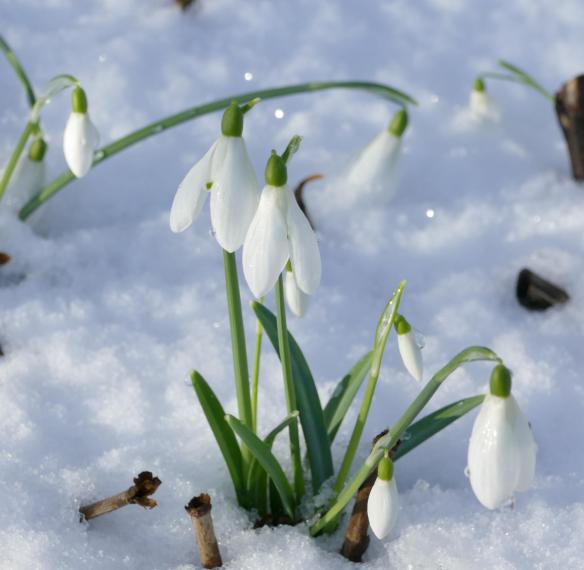 Different bulbs at deeper locations in a clump will tend to flower later, and some cultivars frequently produce 2 flowers per bulb, at different times, which obviously extends the flowering season. Later flowering forms don’t tend to last in flower for as long, since temperatures are likely to be higher, and thus the flowers grow and mature faster, and the flowers are also more likely to be pollinated in warmer weather, with potential pollinators around. Such pollination obviously then brings their flowering to a fairly speedy close.
Different bulbs at deeper locations in a clump will tend to flower later, and some cultivars frequently produce 2 flowers per bulb, at different times, which obviously extends the flowering season. Later flowering forms don’t tend to last in flower for as long, since temperatures are likely to be higher, and thus the flowers grow and mature faster, and the flowers are also more likely to be pollinated in warmer weather, with potential pollinators around. Such pollination obviously then brings their flowering to a fairly speedy close. 
- For those intrigued by some of the photo backgrounds, many of the named cultivars are growing in the retyred matrix part of our garden. There are also over a million bulbs (I would estimate) elsewhere in the garden growing in a more natural setting.
 The tyres have proved to be an ideal setting for keeping named individual cultivars separate and easily labelled, and providing the moist but free draining conditions during active growth, as well as the shade and generally drier conditions through the summer months, which most snowdrops prefer. In nearly all the examples growing here, the snowdrops are succeeded by perennial plants, mostly chosen for their potential appeal as good nectar or pollen sources, for our diverse native insect population, later in the year.
The tyres have proved to be an ideal setting for keeping named individual cultivars separate and easily labelled, and providing the moist but free draining conditions during active growth, as well as the shade and generally drier conditions through the summer months, which most snowdrops prefer. In nearly all the examples growing here, the snowdrops are succeeded by perennial plants, mostly chosen for their potential appeal as good nectar or pollen sources, for our diverse native insect population, later in the year.
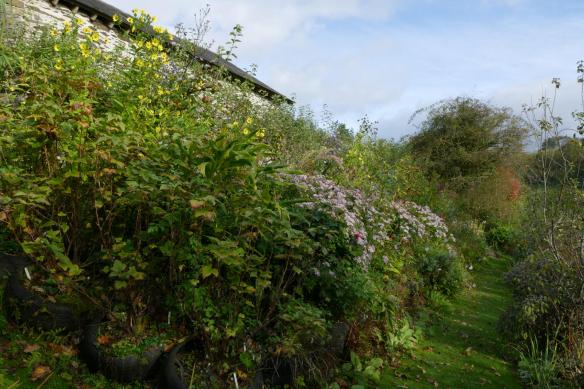
 The bulbs growing in the tyres receive a couple of scatterings of wood ash from our stoves during the year, a single scattering of seaweed meal in early winter, and get mulched with homemade, twice chopped (with our lawnmower to aid decomposition) leaf mould, as soon as possible after cutting back the other herbaceous perennials, in about late October or early November.
The bulbs growing in the tyres receive a couple of scatterings of wood ash from our stoves during the year, a single scattering of seaweed meal in early winter, and get mulched with homemade, twice chopped (with our lawnmower to aid decomposition) leaf mould, as soon as possible after cutting back the other herbaceous perennials, in about late October or early November.  This is around the time that the early season snowdrop shoots are nosing through the ground. In the rest of the garden the snowdrops get similar treatment, but just natural leaf fall, with no mulch. Fallen leaves are never removed from most of the garden, just the paths.
This is around the time that the early season snowdrop shoots are nosing through the ground. In the rest of the garden the snowdrops get similar treatment, but just natural leaf fall, with no mulch. Fallen leaves are never removed from most of the garden, just the paths.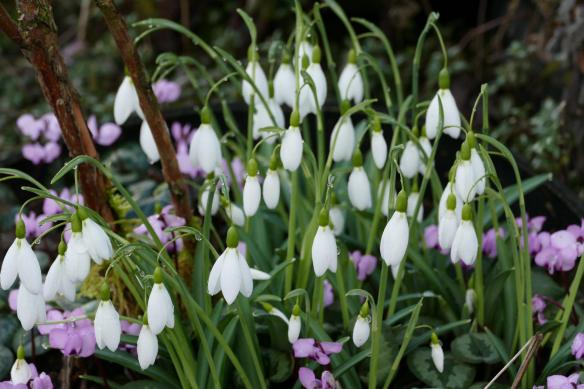
- Currently, named varieties are lifted and split about every 3 to 4 years within the tyres, once there are a few flowers per cluster, with the aim of eventually creating a bolder impression of what the varieties can look like en-masse. Though like many gardening plans, one needs a patient approach towards this goal. Some cultivars are so slow to bulk up that this effect will probably never be seen. At least by me. This lifting and moving can only be done in winter or early spring, since the perennial plants prevent access during the bulb’s dormant period. Though as from 2019, I aim to complete this even earlier – from early December onwards, as soon as the cultivar’s bulb shoots begin to nose through. I’m convinced this stresses the plants less, since they have well developed roots, but minimal foliage to support.
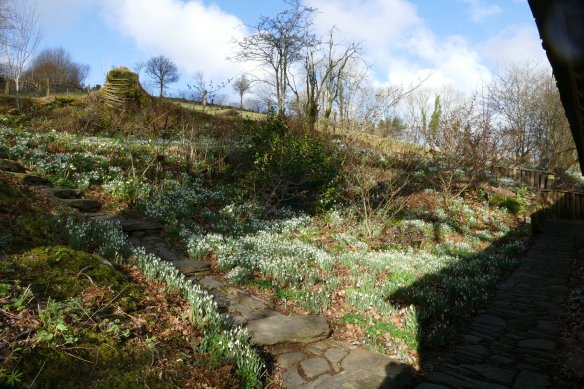 Many snowdrop experts would say bulbs should only be moved when dormant, in summer, but provided I do it during a period of damp or wet weather, with minimal root disturbance, I only get a minor drop off in flowering the following year. However we are “blessed” here with a typical range of 1700 to 2100 mm of annual rainfall, which is much higher than many parts of the UK, and increasing over the winter months, in recent years. (G. ‘Grumpy’, below).
Many snowdrop experts would say bulbs should only be moved when dormant, in summer, but provided I do it during a period of damp or wet weather, with minimal root disturbance, I only get a minor drop off in flowering the following year. However we are “blessed” here with a typical range of 1700 to 2100 mm of annual rainfall, which is much higher than many parts of the UK, and increasing over the winter months, in recent years. (G. ‘Grumpy’, below).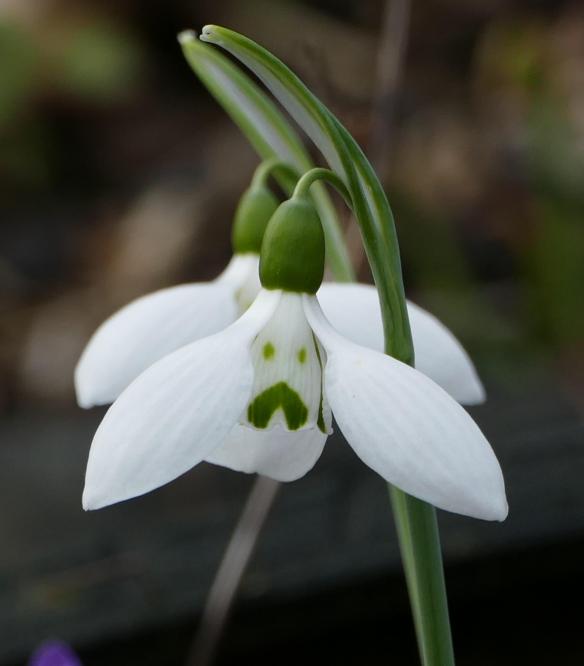
(Our snowdrop silk scarf design above – see separate web page for more details).
Mid Season
Middle of January to beginning of February.
(Since I started this online record, the majority of snowdrops have begun to flower earlier in most years. As a consequence, in 2020, I’ve shifted several cultivars into the early, or indeed this mid season section. Within this group, I’m also going to change the arbitrary “end date” of this first flower appearance to the beginning of February, rather than the middle, to reflect these changes in phenology, probably linked to climate change. It will also make each season a little more equal in numbers. I tend not to be so interested in later flowering snowdrops, since the flowers inevitably don’t last for as long, and heading into March, there are other exciting things happening in the garden).
Out of interest, for the 2022 season, many snowdrops are emerging 7 to 10 days later than in recent years, possibly because of the generally low light levels through most of November to January, reducing the warming effect of the sun on the ground. I’m going to stop updating this page from 2022, since with nearly 350 varieties, it becomes a tedious task. Other than to say the current season was another slow-to-begin one.
_____________________________
G. elwesii ‘Comet’.(? an element of doubt about this one). Acq. 2013. A large single flowered hybrid, with broad glaucous leaves. Moved. Bizarrely in 2022, each bulb seems to be throwing up a semi-double flower offset.(January 16th 2017 – 63rd to flower in 2017, January 24th 2019, January 28th 2022 – 159th to flower).




______________________
G. nivalis WHSH LL MS TS. Acq. 2016. A tall, and early local variant of the species from a site with some wonderful history and related personal stories from the owner. (January 16th 2017, January 24th 2018; January 6th 2019, January 14th 2020 – 97th to flower, January 13th 2022 – 57th to flower.)





 ______________________________
______________________________
G. nivalis WHSH MT M 1 Acq. 2019. One of a few forms from an ancient churchyard with many snowdrops and other bulbs, with a resident honey bee colony in the roof.(January 16th 2020 – 106th to flower. January 23rd 2022 – 117th to flower)
G. x valentinei. Acq? Unknown origin, this very attractive snowdrop is one of our top 5 favourites. Where it came from is a mystery. This name is used for single flowered hybrids of G. nivalis and G. plicatus. The wide flat blue green leaves splay out as the flower emerges, with an obviously paler central line. The flower is quite rounded on a very straight pedicel. It is very floriferous and very vigorous in our garden wherever it is planted. It even seems to thrive in larger pots. (January 16th 2017, January 13th 2018, January 11th 2019 – split, January 24th 2020 – 199th to flower, January 21st 2022 – 101st to flower.)




G. ‘Dionysus’ 10-2. Acq. 2010. A Greatorex double flowered hybrid between G. nivalis florepleno and G. plicatus. (January 16th 2017,. 2018 -NA; January 6th 2019, January 18th 2020 – 132 nd to flower, January 20th 2022 – 93rd to flower).





________________________
G. nivalis WHSH P Y B R Acq. 2014. A local variant of the native species, with a degree of a variation on inner segment markings.(January 17th 2017, January 13th 2018; January 6th 2019, January 29th 2020 – 172nd to flower, January 29th 2022 – 172nd to flower.)




G. nivalis WHSH MT M 2 FLP Acq 2019. One of a few forms from an ancient churchyard with many snowdrops and other bulbs, with a resident honey bee colony in the roof. (January 24th 2020 – 194th to flower, January 29th 2022 – 184th to flower)
G. nivalis WHSH FLGO MD M SV. Acq. Jan 2018. A local form of the species. (February 7th 2019, January 15th 2020 – 101st to flower, January 28th 2022 – 165th to flower)
G. plicatus ‘Sarah Dumont’. Acq. 2018. A lovely strong, yellow flowering hybrid, as vigorous it seems as G. ‘Primrose Warburg’ at least here. One of our favourite 2 yellow forms. (January 26th 2019, January 17th 2020 – 117th to flower, January 27th 2022 – 146th to flower). 

G. nivalis WHSH WTSWW MN CTG, Acq. 2016. A local form of the species. (January 26th 2017, January 13th 2018, January 7th 2019, January 17th 2020 – 121st to flower, January 19th 2022 – 87th to flower)



 ___________
___________
G. nivalis WHSH FIF TG. 1 Acq. 2017 from an old mill within 150 yards of the sea. Some of the earliest flowering coastal origin snowdrops, which I’ve encountered. (January 15th 2018 – 117th to flower, January 7th 2019 – 96th to flower, January 17th 2020 – 122nd to flower, January 17th 2022 – 152nd to flower).


 __________
__________
G. nivalis WHSH FIF TG. 2 Acq. 2017 A differently marked form from the same site – indistinguishable until the flowers open. Difficult to distinguish from others, over time.
_____________
G. nivalis WHSH T NW TG. 1 Acq 2017. A local form, from close to the sea. (January 21st 2018, January 12th 2019, January 17th 2020 – 126th to flower, January 29th 2022 – 181st to flower).


 ___________
___________
G. elwesii ‘Ballard’s No Notch’. Acq. 2014. A cultivar of the species with particularly wide glaucescent foliage, and distinctive inner segments which have no notch in the lower edge. (January 17th 2017, January 1st 2018 – 50th to flower, split, January 12th 2019, January 26th 2020 – 196th to flower, January 15th 2022 – 63rd to flower).





_______________
G. ‘Sentinel’ Acq. 2013. A single flowered, probably G. plicatus X G. nivalis hybrid with separated apical and basal inner segment markings. Strong growing and often 2 scapes per bulb. (January 19th 2017, January 13th 2018; January 1st 2019, January 18th 2020 – 130th to flower, January 20th 2022 – 91st to flower).
_________________________
G. nivalis WHSH NV CY NV 1. Acq. 2020. A local early, and short, but not very vigorous form. (January 18th 2020, January 31st 2022 – 199th to flower).
G. ‘Mrs. Backhouse No. 12’. Acq. 2012. A single flowered hybrid, probably between G. nivalis and G. plicatus. (January 20th 2017, January 13th 2018, January 13th 2019 – part split, January 18th 2020 – 131st to flower, January 25th 2022 – 122nd to flower).


G. nivalis WHSH BDL 2. Acq. 2016. A large number of local varieties of the native species, from a single small site, including one double form. (January 20th 2017,. January 1st 2018; January 8th 2019, January 27th 2022 – 144th to flower). 

___________________________
G. ‘Myddleton Giant’. Acq. 2015. A large flowered, plicated leaf hybrid with olive green ovary, which sulked until it was moved. (January 20th 2017,.January 17th 2018 –118th to flower, No flower 2019 – split/moved, 2020 NF, January 18th 2022 – 74th to flower,).
_________________________
G. ‘David Baker’. Acq. 2015. A single flowered hybrid with green outer segment markings, and slightly flared ends to these segments. Not very vigorous, small green marks to outer segment tips. (January 20th 2017, January 13th 2018; January 7th 2019 – split, January 18th 2020 – 128th to flower, January 12th 2022 – 55th to flower).
___________________________
G. ‘Tubby Merlin’. Acq. 2011. A single flowered hybrid with the inner segment marking of uniform colour, and covering more than the apical half. Slightly olive tinge to ovary. (January 22nd 2017, January 15th 2018; January 12th 2019, split, January 23rd 2020 – 167th to flower, January 28th 2022 – 156th to flower).




G. ‘Washfield Colesbourne’. Acq. 2013. A single flowered hybrid with even coloured inner segment markings covering more than the apical half. (January 23rd 2017 – 90th to flower, January 23rd 2018; January 12th 2019 – split, January 22nd 2020 – 147th to flower, January 29th 2022 – 173rd to flower)
__________________
G. ‘Ermine Farm’. Acq. 2016. A tidy, pretty, and quite narrow, double form. (February 15th 2017 – 180th to flower, January 24th 2019, January 13th 2020 – 91st to flower, January 19th 2022 – 78th to flower).



G. nivalis ‘Gloria’. Acq. 2017. A poculiform variety of the species, originating from France. Like most G. nivalis poculiform snowdrops, (where the inner and outer segments are of similar length) it doesn’t seem to be very vigorous here. (February 18th 2017, January 15th 2018 – 105th to flower, January 17th 2020 – 114th to flower, January 11th 2022 – 45th to flower).
G. ‘Natalie Garton’. Acq. 2015. A semi-double flowered hybrid of G. elwesii. Lovely proportions to the flowers. One of our favourite double snowdrops. (January 23rd 2017, January 23rd 2017 (Spilt), January 13th 2018; January, January 12th 2019, January 16th 2020 – 104th to flower, January 20th 2022 – 88th to flower). 

G. nivalis ex Colesbourne Manor. Acq 2017. Typical form from possibly the greatest English snowdrop garden. (February 23rd 2017, 2018, 2019 NA – split, January 16th 2020 – 107th to flower, January 31st 2022 – 204th to flower).
G. nivalis WHSH C PGO NEO FLP. Acq. 2017. From an unusual wet, wooded site with almost exclusively double forms. (January 13th 2019, January 16th 2020 – 107th to flower, January 30th 2022 – 192nd to flower).


____
G. plicatus ‘Percy Picton’. Acq. 2012. A species cultivar with very long pedicel and also seeds quite well. Inner segment markings are diffused. One of our favourite snowdrops. (January 23rd 2017, January 13th 2018, January 7th 2019, January 22nd 2020 – 156th to flower, January 28th 2022 – 160th to flower.)
______________
G. plicatus ‘Madeleine’. Acq. 2015. A fairly vigorous yellow flowered cultivar of G. plicatus. (January 23rd 2017, January 15th 2018 – split, January 12th 2019 – split, January 23rd 2020 – 177th to flower, January 31st 2022 – 197th to flower.)





_______________________
G. ‘Lavinia’ (North of Mad.) Acq 2011. A Greatorex double, with the outer part of the inner segment markings staining up towards the base. Very poor do-er here, (January 23rd 2017, January 24th 2020 – 188th to flower, January 25th 2022 – 124th to flower.)

________________________
G. ‘White Swan’. Acq. 2015. A tall, double flowered hybrid, which hardly multiplies here.(January 23rd 2017, January 18th 2018; January 12th 2019, 2020:DNF, 2021: DNF, January 17th 2022 – 69th to flower.)




____________________________
G. nivalis poculiformis group ‘Angelique’. Acq. 2012. Of French origin, a distinctive G. nivalis form with similar sized outer and inner segments, and 2 green dots on the inner segments. (January 24th 2017, January 20th 2018; January 14th 2019, January 25th 2020 – 195th to flower, January 23rd 2022 – 114th to flower.)




G. ‘Mrs. Thompson’. Acq. 2012. A hybrid single flowered snowdrop known for its variability in flower form, sometimes producing fused flowers of novelty and charm, or 2 flowers on separate pedicels from the same scape, even from the same small clump. (January 24th 2017, January 19th 2018; January 13th 2019 – split, January 22nd 2020 – 141st to flower, January 29th 2022 – 169th to flower). 





________________________
G. nivalis flore pleno WHSH NEO MS FLP 1. Acq. 2014. A selection of single and double forms of the native species from this old site dating back originally to the C13th. Taken a long time to settle down in the garden. (January 24th 2017, 2018 NA, January 8th 2019, January 17th 2020, January 17th 2022 – 143rd to flower).
______________________________
G. nivalis flore pleno WHSH NEO MS FLP 2. Acq. 2014. Another double form from this site, later flowering with larger conical ovary and messier flowers. (January 28th 2016,January 24th 2017, 2018 NA, 2019 NA, January 23rd 2020, January 29th 2022 – 177th to flower).


 ____________
____________
G. elwesii ‘Grumpy’. Acq. 2015. A cultivar of the species, with wide leaves and a slightly disproportionately small flower with appropriately grumpy face markings. (January 25th 2017, January 5th 2018 – 63rd to flower, January 11th 2019, January 22nd 2020 – 154th to flower, January 21st 2022 – 99th to flower).





________________________
G. ‘Green Necklace’. Acq. 2013. A very vigorous, fairly short, single flowered hybrid, with an attractive, blurred basal inner segment mark. Bought the same year, and from the same source as the previous G. ‘Ailwyn’ which produced just 1 flower in 2013, this cultivar produced 33, in spite of being moved once, because of overcrowding. All snowdrops aren’t the same when it comes to garden worthiness!! (January 25th 2017, January 18th 2018; January 17th 2019, part split, January 22nd 2020 – 153rd to flower, January 24th 2022 – 121st to flower) A very vigorous, garden favourite snowdrop. 





G. ‘Bertha’. Acq. 2019. A smaller hybrid double snowdrop with green outer segments and double inners. (January 22nd 2020 – 157th to flower, February 1st 2022 – 210th to flower.)


G. ‘Trumps’. Acq. 2014. A single flowered hybrid with outer segment green markings and abnormal flower shape.(January 27th 2017, January 18th 2018, January 16th 2019. January 22nd 2020 – 160th flower, January 23rd 2022 – 113th to flower).
G. ‘Hill Poe’. Acq. 2011. A very old, double flowered hybrid snowdrop, originally from Eire. Usually the flowers have 5 outer segments, and very neat and tightly packed inner segments.(January 27th 2017, January 12th 2018, January 26th 2019 – split, January 12th 2020 – 82nd to flower, January 24th 2022 – 120th to flower).
_________________________
G. ‘Imbolc’. Acq. 2010. A single flowered hybrid of short height, with blurred inner segment markings towards the base. A favourite garden snowdrop here. (January 27th 2017, January 27th 2018 – part split, January 26th 2019, January 31st 2020 – 224th to flower, February 6th 2022 – 234th to flower)
__________________
G. ‘Longstowe’. Acq. 2012. A vigorous single flowered hybrid. (January 28th 2017, January 23rd 2018 part split, January 13th 2019, January 22nd 2020 – 149th to flower, January 29th 2022 – 176th to flower).
_______________________
G. ‘Alison Hilary’. Acq. 2012. A single flowered hybrid with inner segment markings diffused over the basal half. Not vigorous with us. (January 28th 2017, January 23rd 2018, January 12th 2019, January 29th 2020 – 208th to flower, February 6th 2022 – 235th to flower).
G. nivalis ‘Scharlockii’. Acq. 2010. An old cultivar of the species, originally from Germany, which can grow “true” from seed, giving rise to some variations in plant size. Very long spathe, pedicel and green tipped outer segments. (January 28th 2017, January 13th 2018 – split, January 15th 2019, January 27th 2020 – 203rd to flower, January 29th 2022 -178th to flower)
G. ‘Little John’. Acq. 2013. Not very vigorous here. A tall single flowered hybrid with even coloured inner segment markings covering more than the apical half. has a distinctive paler section before a slight kink on the flower stem, a bit like the stem bend in a ‘Bent’ type of grass (January 28th 2017, January 22nd 2018, January 27th 2019 – split, January 24th 2020 – 186th to flower, January 29th 2022 – 174th to flower.)
__________________________
G. ‘Ginn’s Imperati’. Acq. 2012. A single flowered hybrid very similar to a large native Italian form of G. nivalis, but with slight leaf form variations. (January 28th 2017, January 20th 2018, January 15th 2019, January 18th 2020 – 134th to flower – split, January 22nd 2022 – 108th to flower).
G. ‘Modern Art’. Acq. 2015. A single flowered hybrid with green tips to the outer segments. Takes a long time for the flowers to progress and open. (January 28th 2017, January 13th 2018, January 12th 2019 – split, January 23rd 2020 – 168th to flower, January 11th 2022 – 48th to flower).
____________________
G. ‘Primrose Warburg’. Acq. 2013. A single flowered hybrid with yellow inner segment markings and ovary. Vigorous here. One of our top 2 yellow flowered snowdrops, along with G. ‘Sarah Dumont’. (January 28th 2017 – 120th to flower in 2017, January 24th 2018, January 19th 2019 – Part split, January 30th 2020 – 216th to flower, February 1st 2022 – 207th to flower).
G. elwesii ‘Lord Monostictus’. Acq. 2013. A single inner segment mark cultivar of the species. (January 28th 2017, January 25th 2018, January 5th 2019, January 31st 2020 – 225th to flower, February 3rd 2022 – 223rd to flower).
______________________________
G. ‘Spindlestone Surprise’. Acq. 2012. A naturally formed single flowered hybrid, probably between the “native” yellow Sandersii form of G. nivalis found in Northumberland, and G. plicatus. Distinctive yellow ovary and inner segment markings. (January 28th 2017, January 20th 2018, January 12th 2019, January 23rd 2020 – 164th to flower, January 28th 2022 – 155th to flower).
___________________
G. ‘Ketton’. Acq. 2012. A single flowered hybrid with 2 blurred basal inner segment marks.(January 28th 2017, January 20th 2018, January 19th 2019, January 14th 2020 – 96th to flower, January 22nd 2022 – 104th to flower).
_______________________
G. nivalis WHSH DAR CM. Acq. 2016. A local form of the native species, one bulb with aberrant tepals. (January 28th 2017, February 7th 2019)
G. nivalis WHSH TL AB L. Acq. 2016. A local form of the native species. (January 28th 2017, February 7th 2019, February 6th 2022 – 243rd to flower).
____________________________
G. nivalis WHSH CDH SS. Acq. 1995. Our original snowdrop. A form of the native species brought to Gelli Uchaf as the first ever snowdrops, from our home in Bristol. Originally sourced from Fiona’s parents house in Shropshire, and they acquired it from a very old estate in Shropshire! A much travelled, floriferous and vigorous snowdrop. (January 28th 2017, January 20th 2018, January 7th 2019, January 16th 2020, January 23rd 2022 – 118th to flower). A firm garden favourite, and by far and away the most numerous form we have in the garden, since it’s the only one we grew and split for many of the early years of garden development.





____________________________
G. ‘Desdemona’ ? (TLO 4N). Acq.? A vigorous Greatorex double hybrid with inner segment markings staining up to their base. (January 28th 2017, December 31st 2021 – 20th to flower).
_______________________
G. elwesii ‘Kite’. Acq 2013. A cultivar of the species with even coloured inner segment markings, and often 2 flowers on separate pedicels from the same scape. (January 30th 2017, January 22nd 2018, January 10th 2019, January 29th 2020 – 212th to flower, January 23rd 2022 – 111th to flower).
G. ‘Melanie Broughton’. Acq. 2012. A single flowered hybrid with even coloured inner segment markings covering more than the apical half. One of our favourite vigorous and floriferous snowdrops. (January 30th 2017, January 18th 2018, January 5th 2019 – part split, January 24th 2020 – 186th to flower – part split, January 29th 2022 – 171st to flower).
_____________________
G. nivalis WHSH EID LGN 1. Acq. 2017, Local form from site with 2 different flowering clones. (January 26th 2018, January 12th 2019, January 17th 2020 – 125th to flower, January 31st 2022 – 206th to flower).
 _____________
_____________
G. nivalis WHSH T M LG 1 . Acq. 2018. A G. nivalis from a property with 3 or 4 distinct forms. (January 8th 2019, January 17th 2020 – 124th to flower, January 25th 2022 – 127th to flower.) __________
__________
G. nivalis WHSH TM LG 2 FLP. Acq 2018. A double form from a local site. (January 23rd 2020 – 181st to flower, January 31st 2022 – 203rd to flower) 


________
G. nivalis WHSH FNN M BC 1 Acq. 2016: Several forms from this grand Pembrokeshire property. (January 22nd 2018, January 21st 2019, January 18th 2020 – 138th to flower, January 31st 2022 – 195th to flower.)
G. nivalis WHSH LDFS 4. Acq. 2017. One of five or more forms from this local site, slightly olive green ovary on this mid flowering shorter form. Taking a few years to sort them all out. (January 18th 2020 – 137th to flower.)
G. nivalis WHSH LDFS FLP. 5 Acq 2017: A short, vigorous local double form from a site with several forms. (January 14th 2019, January 18th 2020 – 137th to flower, January 20th 2022 – 96th to flower).
G. nivalis ‘Viridapice’. Acq. 2010. One of the oldest green tipped outer segment forms of G. nivalis, originating from Holland. (January 30th 2017 – 130th to flower, January 19th 2018, January 14th 2019, January 22nd 2020 – 148th to flower, January 29th 2022 – 175th to flower).
G. nivalis flore pleno WHSH CP CM FLP. Acq. 2016. A large flowered double or flore pleno local form of the native species. (January 30th 2017, January 15th 2018, January 19th 2019, January 23rd 2020 – 182nd to flower, February 1st 2022 – 213rd to flower).
G. nivalis WHSH CR W FLP 1. Acq. 2017. A pretty small local form of the double nivalis. (January 24th 2019, January 23rd 2020 – 158th to flower, January 26th 2022 – 138th to flower).
_______
G. nivalis WHSH GRLF PYR 1. Acq. 2018. A secluded rural site with a few different forms, singles and doubles. (January 19th 2019, January 23rd 2020, January 29th 2022 –185th to flower).
_____________
G. nivalis flore pleno WHSH T G CIA AR. Acq. 2015. A local double form of the native species.(January 30th 2017, January 26th 2018, January 20th 2019, January 24th 2020 – 198th to flower, January 28th 2022 – 162nd to flower).
______________________________
G. nivalis WHSH GRLF PYR FLP 2. Acq. 2018. A double form from a rural site with several different forms. (January 28th 2019, January 25th 2020, February 1st 2022 – 209th to flower).


__________
G. ‘Winifrede Matthias’ (?). Acq. 2012. A short and small, single flowered hybrid with pale green ovary and arching pedicel. (January 30th 2017, January 14th 2018, January 13th 2019, January 23rd 2020 – 173rd to flower, January 26th 2022 – 133rd to flower).
G. ‘Orleton’. Acq,. 2016. A single flowered hybrid of G. nivalis and G. plcatus. (January 31st 2017, January 17th 2018, January 13th 2019, January 24th 2020 – 191st to flower, January 23rd 2022 – 116th to flower).
___________________
G. nivalis ‘Alan’s Treat’. Acq. 2014. A weak poculiform cultivar of the species with green tips to the outer segments. (January 31st 2017, No flower-2018, January 27th 2019, etc…! Probably died)
__________________
G. nivalis ex Cambo. Acq.2016. A later flowering, vigorous form of the species from one of the best Scottish sites for snowdrops. (January 31st 2017, January 27th 2018, January 17th 2019, January 30th 2020 – 218th to flower, February 2nd 2022 – 220th to flower).
__________________________
G. plicatus WHSH FFNN M 1. Acq. 2016. A locally found cultivar of the species, from a site with several variants of G. nivalis, proving difficult to separate out in the garden. (January 31st 2017, January 31st 2022 – 195th to flower)
_____________________
G. nivalis ex South Cerney. Acq. 2016. A variant of the native species from the gardens at this old Cotswold property. Pretty inner segment markings on ridged segments. (January 31st 2017, January 26th 2018, January 24th 2019, January 26th 2020 – 202nd to flower, January 29th 2022 – 182nd to flower).
______________________
G. plicatus ‘Augustus’. Acq. 2010. A distinctive virus infected cultivar of the species with obviously puckered outer segments to the flowers. (January 31st 2017, January 22nd 2018, January 12th 2019, January 28th 2020, January 28th 2022 – 164th to flower).
_______________________
G. ‘Bitton’ (3-2N – moved to upper Hydr.tyre 1.) Acq? Distinctive olive green flowers and ovaries. (January 31st 2017- 140th to flower, January 22nd 2018, January 8th 2019. January 13th 2020 – 94th to flower, January 22nd 2022 – 109th to flower).
G. nivalis ‘Elfin’. Acq. 2012. A very pretty small form of the native species. Flowers often “open” vertically and have green tipped outers. Not particularly long lasting flowers. (January 31st 2017, January 31st 2017, January 23rd 2018 – split, January 24th 2019 – split, February 3rd 2020 – 245th to flower, February 6th 2022 – 242nd to flower)
_____________________________
G. nivalis WHSH PBB 1. Acq. 2019. A local form. (January 17th 2020 – 123rd to flower, February 1st 2022 – 214th to flower).

G. nivalis WHSH P TFG CDG 1. Acq. 2016. A local form of the native species.(January 31st 2017, January 27th 2018, January 26th 2019, January 27th 2020 – 204th to flower, February 5th 2022 – 231st to flower.)


G. nivalis WHSH BB W HM LYBD 1. Acq. 2018. A local form with the longest ovary in proportion to the segments of any G. nivalis we have. Named by me as G. ‘Whelm’, as in Ova whelm, since its appearance co-incided with the onset of Covid in 2020. Really very dainty, and a distinctive favourite. (January 21st 2019, January 23rd 2020 – 179th to flower, January 29th 2022 – 179th to flower)


G. nivalis WHSH BB W HM LYBD 2. Acq. 2018. Another form from the same site with chunkier ovary. (January 23rd 2020).
G. ‘Bill Bishop’. Acq. 2012. A lovely single flowered hybrid, with large flowers, fairly vigorous here. (February 1st 2017, January 22nd 2018, January 13th 2019, January 22nd 2020 – 161st to flower, January 29th 2022 – 167th to flower).
________________________
G. ‘The Wizard’. Acq. 2019. A ‘Trym’ like snowdrop with flared outer segments with green splashes on the tips. (January 31st 2020 – 229th to flower).
G. ‘Icicle’. Acq. 2013. A shorter attractive, single flowered hybrid. (February 1st 2017, January 26th 2018, January 24 h 2019 -split, January 31st 2020 – 226th to flower, January 31st 2022 – 193rd to flower).
__________________________
G. elwesii ‘Louise Ann Bromley’. Acq. 2015. A cultivar of the species with very wide leaves and large flowers. (February 1st 2017, January 22nd 2018, January 9th 2019. January 22nd 2020 – 140th to flower, January 19th 2022 – 76th to flower)
_____________________________
G. ‘Erway’. Acq. 2016. A small, single flowered hybrid with very distinctive shiny olive green, long ovary and diffused inner segment marking over the most of the segment. (February 1st 2017, January 19th 2018, January 21st 2019, January 26th 2022 – 129th to flower).
G. Unknown 21-4. Acq? A very distinctive snowdrop with broad foliage looking like an G. elwesii X G. plicatus hybrid, and split single dot apical inner segment markings. But I don’t seem to have a name for it – the closest similar I can find is G. ‘Deer Slot’, but I’ve never bought this. Any ideas? (February 1st 2017, January 15th 2018, January 8th 2019, January 30th 2020 – 213th to flower, January 20th 2022 – 89th to flower).
____________________
G. nivalis flore pleno WHSH RYGW MS FLP. Acq. 2015. A variety of the native double form of the species, of local origin (February 1st 2017, 2018 NA, January 17th 2019, January 26th 2020 –198th to flower, February 5th 2022 – 227th to flower).
G. ‘Kew Green’. Acq. 2015. A single flowered hybrid. (February 2nd 2017, January 27th 2018 split, February 6th 2019, January 24th 2020 – 183rd to flower, January 29th 2022 – 169th to flower).
____________________
G. nivalis WHSH P Y C KDW FLP. Acq. 2014. A local variety of the native double snowdrop, G. nivalis flore pleno, but not at all vigorous with us, unlike the following snowdrop. (February 2nd 2017 – 150th to flower, January 25th 2018, January 21st 2019, January 24th 2020 – 184th to flower, January 30th 2022 – 188th to flower).
G. nivalis flore pleno WHSH PG KDW FLP 2 JJ . Acq. 2017. A neat, short, local form of flore pleno, and quite vigorous too, compared to the other double form from a very nearby source which has millions of single nivalis. (January 25th 2018, January 12th 2019, January 26th 2020 – 200th to flower, January 31st 2022 – 205th to flower).







_____________
G. ‘Seagull’. Acq. 2015. A single, large flowered hybrid. A lovely, favourite bold and vigorous snowdrop (February 2nd 2017, January 24th 2018 – split within tyre, January 14th 2019, January 27th 2022 – 145th to flower).
_________________________
___________________________
G. ‘Excelsis’. Acq. 2014. A single flowered hybrid with diffused marking over the basal part of the inner segments. (February 2nd 2017, January 22nd 2018, January 21st 2019, January 22nd 2020 – 144th to flower, January 27th 2022 – 142nd to flower).
________________________
G. Unknown 8-1. Acq? February 2nd 2017 to early March. Nothing to go on…more photos needed next year!
______________________
G. X ‘Whittington’. Acq. 2012. A single, fairly ordinary flowered hybrid of questionable name! (February 2nd 2017, January 31st 2018, January 26th 2019, January 24th 2020 –195th to flower, February 6th 2022 – 239th to flower.)


 ________________________________
________________________________
G. nivalis flore pleno ‘Lady Elphinstone’. Acq. 2011. A double form of the species (i.e G. n. flore pleno) with yellow inner segment markings, in most years! (February 2nd 2017, January 26th 2018 , January 27th 2019, January 29th 2020 – 211th to flower, February 1st 2022 – 212th to flower).





_________________________
G. ‘Trymposter’. Acq, 2016. A single flowered G. plicatus hybrid, with characteristic flared outer segments with green splashes. (February 3rd 2017, January 31st 2018, January 27th 2019, January 23rd 2020 – 160th to flower, January 31st 2022 – 200th to flower).
_____________________
G. nivalis WHSH BDL 3. Acq. 2016. A local variety of the native species, with slightly olive green ovary, when acquired. (February 3rd 2017, January 7th 2018, January 27th 2019, February 1st 2020, January 27th 2022 – 144th to flower).



______________
G. ‘Sprite’. Acq. 2014. A vigorous, quite tall, single flowered hybrid, with 5 or 6 green lines on outer segment tips. Not the most elegant snowdrop, but still a favourite snowdrop here. (February 4th 2017 – 160th to flower, January 25th 2018, January 20th 2019 – split, January 23rd 2020 – 163rd to flower, January 28th 2022 – 153rd to flower.)





________________________________
G. nivalis ‘Blonde Inge’. Acq. 2014. Of German origin, a small form of the species, with green ovary, but yellow or sometimes yellow and green inner segment markings. Very vigorous here. A garden favourite snowdrop. (February 5th 2017, January 27th 2018, January 28th 2019, February 1st 2020 – 233rd to flower, February 5th 2022 – 228th to flower).
_________________
G. ‘Wasp’. Acq. 2015. A single flowered hybrid with long narrow outer segments, and separate apical and basal marks, though these marks seem a bit variable from one flower to another. (February 5th 2017, January 17th 2018, January 12th 2019, January 12th 2020 – 75th to flower, January 21st 2022 – 102nd to flower.).
____________________________
G. nivalis WHSH MGW FLP 1. Acq . 2019. A vigorous local double form, typically untidy, from a site where as often is the case, the double forms emerge before the later singles. (January 23rd 2020 – 180th to flower, January 29th 2022 – 180th to flower).
__________
G. ‘Peardrop’. Acq. 2015. A lovely bold, single flowered hybrid with scissor like blurred basal marks extending up from the strongly dark green apical mark. (February 5th 2017, January 31st 2018, January 27th 2019, January 23rd 2020 – 163rd to flower, January 31st 2022 – 196th to flower).
__________________________
G. ‘Robyn Janey’. Acq. 2016. A single flowered hybrid with separate apical and elongated basal spot markings, beneath a olive green ovary, long arching pedicels, long claws and usually 2 flowers per scape. (February 6th 2017. January 26th 2018, January 27th 2019, February 2nd 2020 – 239th to flower.)
__________________
G. nivalis ‘Munchkin’. Acq. 2016. A small in stature variety of the species with bold green, wide, heart shaped inner segment marking, and outer tips of leaves that tend to curl over. (February 7th 2017, January 31st 2018, January 28th 2019, February 1st 2020 – 238th to flower, February 6th 2022 – 233rd to flower).
___________________________
G. plicatus ‘Wendy’s Gold’. Acq. 2011. A cultivar of the species with yellow markings and ovary. (February 7th 2017 , January 25th 2018, January 19th 2019 – split, January 23rd 2020 – 166th to flower, January 30th 2022 – 189th to flower).





_____________________
G. ‘Nothing Special’ ex RB ex RW! . Acq. 2018. Was given this, having bought but misplaced the location of the original version. (January 17th 2020 – 120th to flower, January 29th 2022 – 187th to flower)

_______________
G. nivalis ‘Tiny’. Acq. 2011. A shorter, and very vigorous single form of the native species. (February 7th 2017, February 8th 2018, January 27th 2019 – split, January 31st 2020 – 230th to flower, February 6th 2022 – 241st to flower.)
___________________________
G. ‘Trotter’s Merlin’. Acq. 2011. A single flowered, vigorous hybrid, with nearly all green inner segment markings. 170th to flower. (February 7th 2017 – 170th to flower, February 8th 2018, February 6th 2019, February 3rd 2022 – 225th to flower.)
 _________________________________
_________________________________
G. plicatus ‘Bowles’ Large Form’. Acq. 2013. A lovely bold, and later flowering form of the species, which always stands out when in flower, with its slightly seersuckered outer segments. Becoming a favourite, if not madly vigorous. (February 7th 2017, January 31st 2018, January 22nd 2019 – split, January 30th 2020 – 215th to flower, February 2nd 2022 – 218th to flower).
G. nivalis ‘Chedworth’. Acq. 2013. A later flowering variety of the native species. (February 10th 2017. January 25th 2018, January 24th 2019, January 31st 2020 – 223rd to flower, ).
 ________________________________
________________________________
G. plicatus subspecies byzantinus ‘Ron Ginn’. Acq. 2017. A vigorous form here, with an interesting inner segment marking. (February 13th 2017, January 17th 2018, January 13th 2019, January 22nd 2020 – 155th to flower, January 27th 2022 – 147th to flower)




____________________
G. nivalis ‘Moreton Mill’. Acq. 2017. A poculiform cultivar (with similar outer and inner segments) of the native species. (February 13th 2017, January 22nd 2018, January 20th 2019, January 24th 2020 – 190th to flower.)
G. ‘Green Comet’. Acq 2017. February 14th 2017 to mid March. A single flowered hybrid with a very long pedicel, and broad foliage. Hasn’t reappeared…
_____________________
G. plicatus ‘Washfield Warham’. Acq. 2010. A reliable and vigorous late flowering cultivar of the species. (February 14th 2017 – 178th to flower, January 29th 2022 – 174th to flower).




_________________________
G. plicatus ‘Vera Trum’. Acq. 2018. A short but very vigorous form of the species. (January 22nd 2019, January 26th 2020 – 199th to flower, split, January 10th 2022 – 43rd to flower.)





G. rizehensis ‘Baytop’. Acq.2016. A later flowering clone of the species with broader foliage. (February 15th 2017, January 25th 2018, January 27th 2019, January 26th 2020 – 200th to flower, February 1st 2022 – 211th to flower.)
___________
G. nivalis sandersii group ‘Lowick’. Acq. 2010. A very weak growing snowdrop here, as can be seen from the once moved plants below, 7 years after acquisition! ( February 18th 2017, January 22nd 2018, January 19th 2019, January 26th 2020 – 201st to flower, February 5th 2022 – 229th to flower.)
G. ‘Fieldgate Superb’. Acq. 2015. A single flowered hybrid, usually 2 flower scapes per shoot. (March 4th 2017, January 27th 2018, January 27th 2019, January 23rd 2020 – 172nd to flower, February 2nd 2022 – 217th to flower).
__________________
G. ikariae ex MB – RB FH. A gift to Ruby Baker from a friend, Margaret Bide, originally from her garden in Farnham where Ruby Baker first saw and recognised it as a different form, and swapped it for some of her own special vigorous doubles. Sadly both ladies are now no longer with us. Acq. 2017
(January 31st 2018, January 26th 2019, January 27th 2020 – 205th to flower, February 5th 2022 – 230th to flower.)


_____
G. elwesii ‘Mary Biddulph’. Acq. 2018. (January 7th 2019, January 29th 2020 – 209th to flower.)


______
G. ‘Rodmarton Arcturus’. Acq. 2017. A bold hybrid snowdrop with large globe like flower, from the wonderful Rodmarton garden. (January 27th 2018, January 30th 2019, January 28th 2020 – 207th to flower). 


__________
G. elwesii monostictus. Acq. 2013. A different form of the species with single inner segment markings. Not very vigorous here – ? poor soil in tyre, or planted too deeply (February 18th 2017, 2018 NF, February 4th 2019, January 28th 2020 – 206th to flower, February 1st 2022 – 206th to flower).
_____________
G. elwesii ‘Sibbertoft Magnet’. Acq. 2013. A cultivar of the species with long, arching pedicel and equally long spathe, curving gently over the flower. A favourite later flowering snowdrop (February 15th 2017,. February 8th 2018, January 26th 2019, January 30th 2020 – 214th to flower, February 3rd 2022 – 222nd to flower.)
______________________________
G. Unknown SP 2. Acq. ? A late flowering, shorter, single hybrid (?), with flowers of pleasing proportions. (February 18th 2017 – 90th to flower. 2018 NA, January 20th 2019, January 31st 2020 – 184th to flower, February 1st 2022 – 208th to flower.) 




________________________
G. ‘Armine’. Acq. 2018. A single flowered hybrid. (January 31st 2020 – 231st to flower, January 27th 2022 – 151st to flower). 


 _________
_________
G. X valentinei ‘Terry Jones’. Acq. 2017. A single flowered hybrid. (January 31st 2018, January 26th 2019, February 1st 2020 – 235th flower).


_________

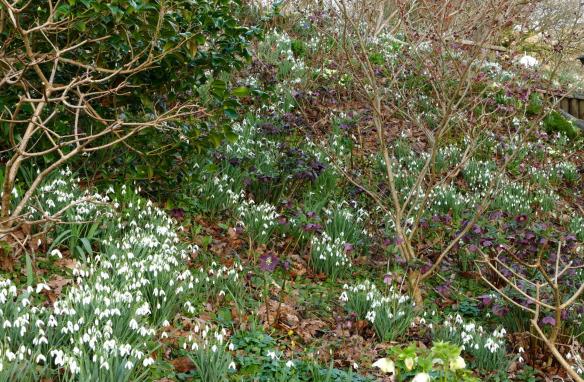
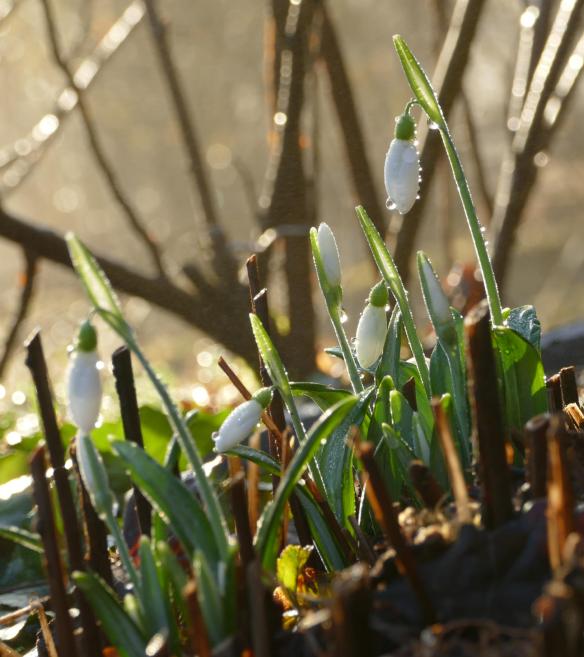


































































































































































 _____________________
_____________________
















 _______________________
_______________________















































































 .
.







































































































